Magpie Cat Lifespan : How Long Do They Live?
Magpie cats generally live 12 to 18 years, depending on their breed background.
Common Black and White Cat Breeds: Magpie Cat Patterns vs. Other Bicolor Coat Types
- Magpie coloration is based on coat patterns, not breed genetics, making it possible in many different breeds.
Magpie Cat vs Tuxedo Cat
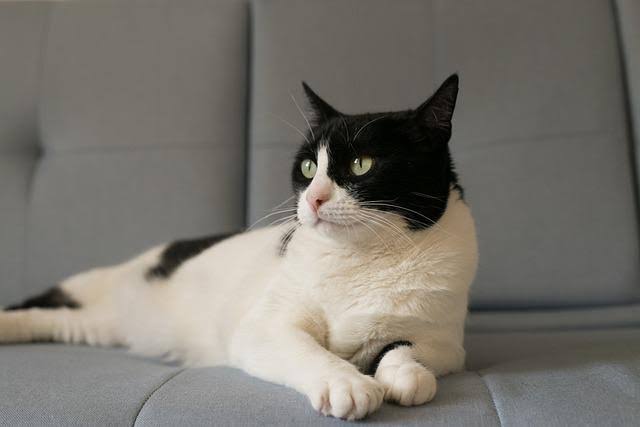
- Breed or Pattern? Pattern
- White Coat Coloring % : Around 30-40% white
- Black and White or Variations? Typically black and white, though occasionally other dark colors like grey with white
- Name Origin: Named for their resemblance to a formal “tuxedo” suit
- Lifespan : Since tuxedo is a pattern, their lifespan varies by breed. However, most tuxedo cats live 10-15 years, with some breeds living longer indoors
Distinguishing Feature: Tuxedo cats are a specific type of bicolor pattern. They are mostly black or dark with distinct white markings on the chest, paws, and sometimes the belly
Magpie Difference: magpie cat vs tuxedo, magpie have a more chaotic, spotted pattern without the clear tuxedo shape.
Harlequin Cats
- Breed or Pattern? Pattern
- White Coat Coloring % : Approximately 75% white
- Black and White or Variations? Can be black and white or other color combinations
- Name Origin: Derived from the character “Harlequin,” known for wearing a costume with irregular patches, which reflects the random patches of color on these cats
- Lifespan : As a pattern, harlequin cats’ lifespan depends on the breed, typically 12-16 years
Distinguishing Feature: Harlequins feature mostly white coats with large, random patches of black or another color. The black is often concentrated on the head and tail.
Magpie Difference: Magpie cats’ spots are smaller, more random, and irregular. somtimes people tend to confuse with term harlequin magpie cat.
Van Cats or Turkish Van
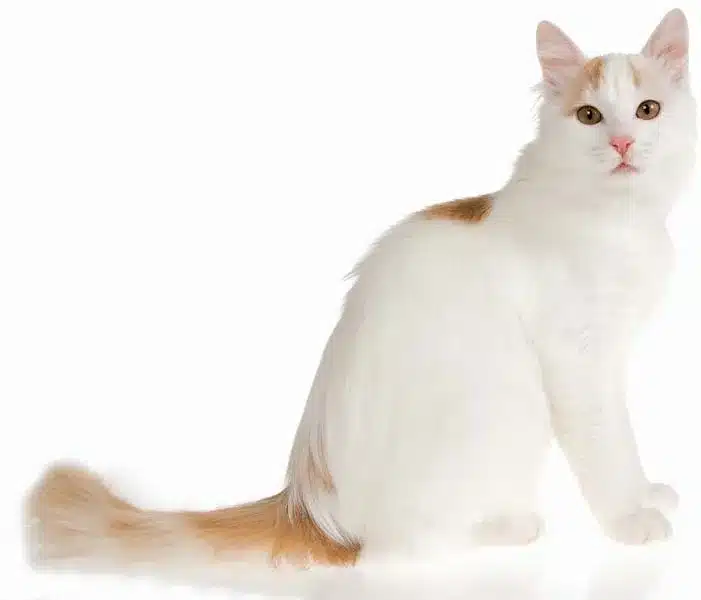
- Breed or Pattern? Breed (Turkish Van) and Pattern (Van)
- White Coat Coloring % : About 80-95% white
- Black and White or Variations? Usually red, cream, or black with white
- Name Origin : Named after the region near Lake Van in Turkey, where the breed originates
- Lifespan : These cats usually live between 12-17 years, known for their robust health
Distinguishing Feature: Van cats, especially the Turkish Van, have a primarily white coat with color limited to the head and tail. The Turkish Van is famous for its van pattern, with solid color on the head and tail, while the rest of the coat remains pure white.
Magpie Difference: Magpie cats have scattered, random patches all over the body.
Cow Cat (Moo Cat)
- Breed or Pattern? Pattern
- White Coat Coloring % : 50-80% white
- Black and White or Variations? Usually black and white
- Name Origin: Named after the large black patches on white fur, which mimic the pattern seen on dairy cows
- Lifespan : A playful term for a bicolor pattern, cow cats generally share the same lifespan as other bicolor cats—around 10-15 years depending on breed
Distinguishing Feature: Cow cats are a playful term for black-and-white bicolor cats with markings that resemble Holstein cows—large black patches on a white background.
Magpie Difference : has smaller, more random and scattered spots.
American Shorthair
- Breed or Pattern? Breed (can have bicolor pattern)
- White Coat Coloring % : Varies depending on the individual cat
- Black and White or Variations? Can come in many colors, including black and white
- Name Origin: Developed in North America, originally bred for hunting and pest control
- Lifespan : These cats have a lifespan of 15-20 years, making them one of the longest-living breeds
Distinguishing Feature: American Shorthair cats can also feature bicolor patterns, but the distribution of black and white varies more and doesn’t follow a set design like tuxedos or vans.
Magpie Difference : magpie has random, irregular spots with no defined structure.
British Shorthair
- Breed or Pattern? Breed (can have bicolor pattern)
- White Coat Coloring % : Varies depending on the individual ca
- Black and White or Variations? Can be black and white or other bicolor combinations
- Name Origin: One of the oldest British cat breeds, historically linked to Roman times
- Lifespan : These sturdy cats live 12-20 years, with proper care
Distinguishing Feature: British Shorthairs can have piebald or bicolor coats as well. Their markings are typically well-defined, often creating a classic bicolor look.
Magpie Difference : magpie has scattered, random patches with no uniformity.
Pied Cat
- Breed or Pattern? Pattern
- White Coat Coloring % : Typically 50% or more white
- Black and White or Variations? Found in a variety of color combinations
- Name Origin: Derived from the word “piebald,” meaning patches of two colors, typically black and white
- Lifespan : As with other patterns, the lifespan of a pied cat depends on the breed, but it’s commonly 10-15 years
Distinguishing Feature: Pied cats share piebald traits, with random patches of white breaking up the dominant color, just like magpie cats.
Magpie Difference : magpie has smaller, more irregular and scattered spots.
Maine Coon
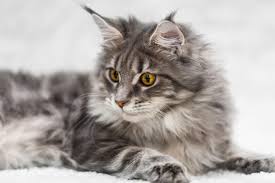
- Breed or Pattern? Breed (can have bicolor pattern)
- White Coat Coloring % : Can vary, but often 25-50% for bicolor patterns
- Black and White or Variations? Can come in many color patterns, including black and white
- Name Origin: Named after the U.S. state of Maine, where the breed originated
- Lifespan : Known for their hardy nature, Maine Coons typically live 12-15 years, though some live longer
Distinguishing Feature : Maine Coons are known for their large size and bushy tails, often with tabby or solid color patterns.
Magpie Difference : Magpie-patterned Maine Coons feature smaller, random black and white patches.
Domestic Shorthair
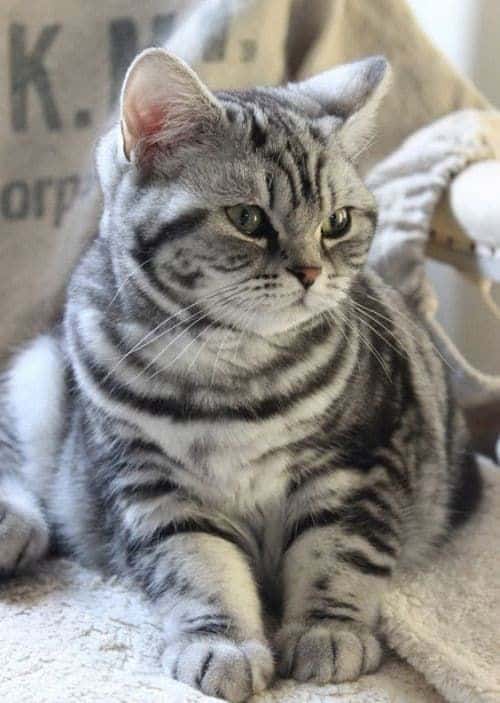
- Breed or Pattern? Breed (can have bicolor pattern)
- White Coat Coloring % : Varies widely
- Black and White or Variations? Can be black and white or other color patterns
- Name Origin : Refers to mixed-breed cats with short fur, common in households
- Lifespan : This non-pedigree group of cats can live up to 20 years, with many falling in the 12-16 years range
Distinguishing Feature : Domestic Shorthairs have varied coat patterns, including tabby, solid, and bicolor.
Magpie Difference: The magpie pattern adds a unique, random mix of black and white to their fur.
Manx
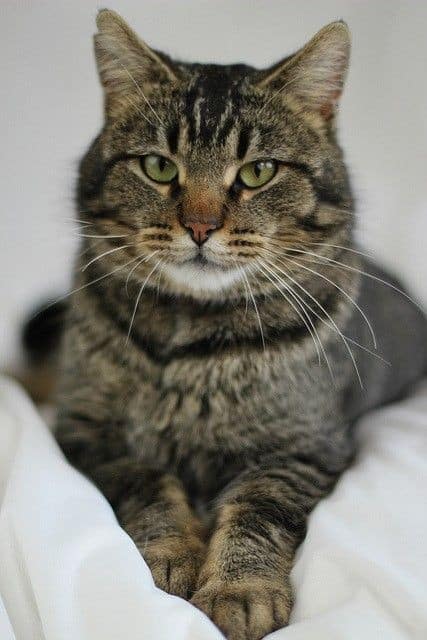
- Breed or Pattern? Breed (can have bicolor pattern)
- White Coat Coloring % : Varies depending on the individual cat
- Black and White or Variations? Can come in black and white or other colors
- Name Origin : Named after the Isle of Man, where the breed is thought to have originated
- Lifespan : The average lifespan for a Manx cat is 12-14 years, with some living beyond tha
Distinguishing Feature: Manx cats are famous for their taillessness and can come in various coat patterns, including bicolor.
Magpie Difference: Manx cats with magpie coats have the signature scattered black-and-white patches, adding to their unique look.
Norwegian Forest Cat
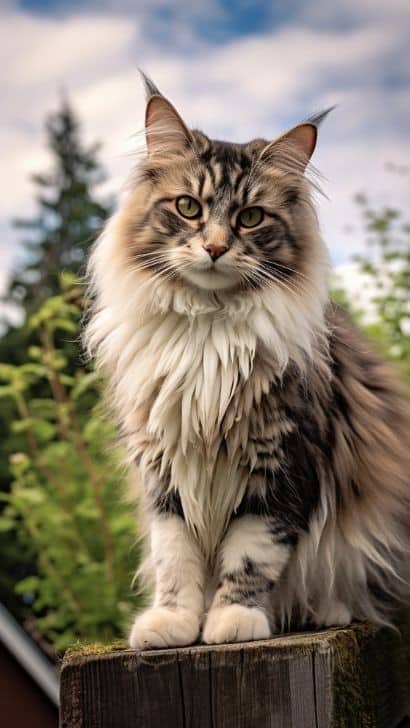
- Breed or Pattern? Breed (can have bicolor pattern)
- White Coat Coloring % : Can vary, but not common in solid white
- Black and White or Variations? Typically solid or tabby, though black and white variations can occur
- Name Origin: Native to Norway, adapted to cold climates
- Lifespan : These large, fluffy cats have a lifespan of 12-16 years
Distinguishing Feature: Known for their long, thick fur, Norwegian Forest Cats typically have solid or tabby coats.
Magpie Difference: Magpie-patterned Norwegian Forest Cats sport random, scattered black-and-white patches, contrasting with their usual coat patterns.
Persian
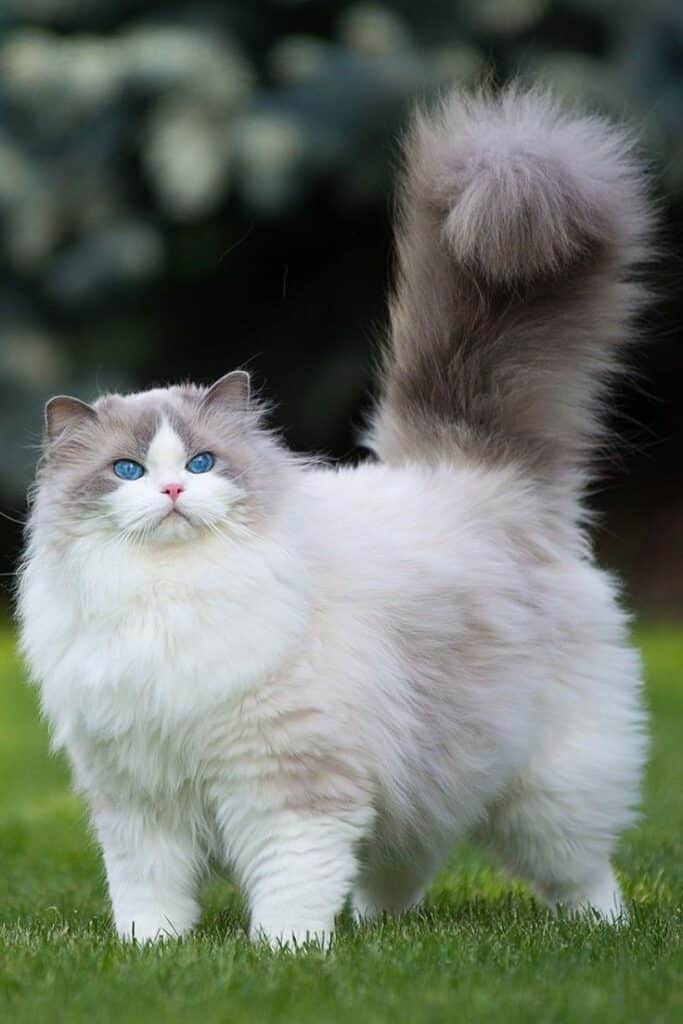
- Breed or Pattern? Breed (can have bicolor pattern)
- White Coat Coloring % : Can vary; some are fully white
- Black and White or Variations? Found in many colors, including bicolor
- Name Origin: Named for its origin in Persia (modern-day Iran)
- Lifespan : Persians live an average of 12-16 years, but their long coat requires careful grooming to avoid health issues
Distinguishing Feature: Persian cats are known for their luxurious, long fur and often solid or tabby colors.
Magpie Difference: Magpie Persians have random black-and-white spots, giving their fluffy coats a unique appearance.
Siberian
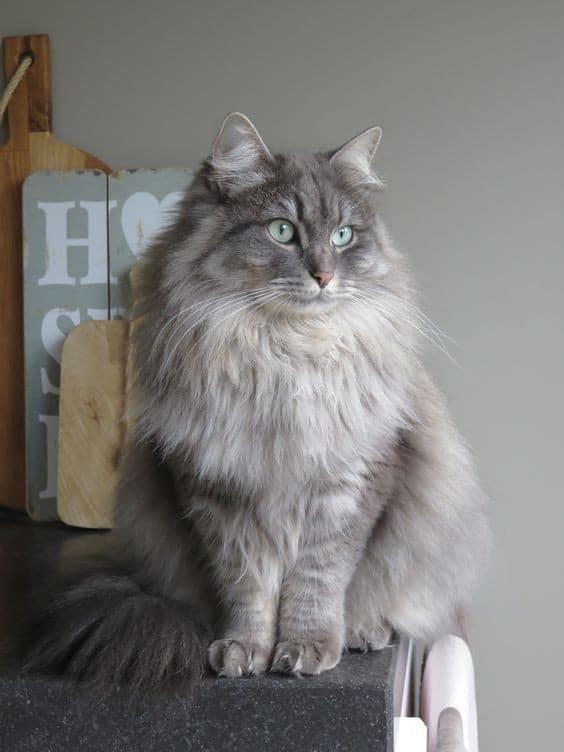
- Breed or Pattern? Breed (can have bicolor pattern)
- White Coat Coloring % : Varies depending on individual cat
- Black and White or Variations? Can be black and white or other color combinations
- Name Origin: Native to Siberia, known for their resilience in cold weather
- Lifespan : These robust cats can live 11-18 years, with some even living beyond 18
Distinguishing Feature: Siberians are large, muscular cats with dense coats, usually in solid or tabby patterns.
Magpie Difference: Magpie Siberians display irregular black and white patches scattered across their thick fur.
Ragdoll
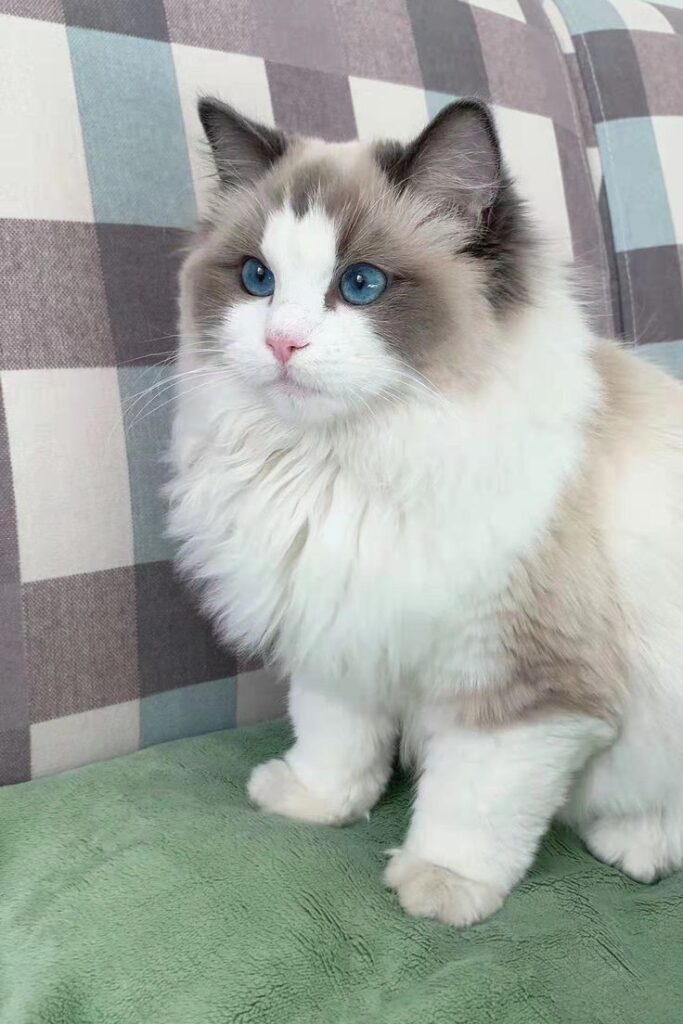
- Breed or Pattern? Breed (can have bicolor pattern)
- White Coat Coloring % : Not common, mostly color-point patterns
- Black and White or Variations? Rare for black and white; typically color-point
- Name Origin: Named for their tendency to go limp when picked up, like a ragdoll
- Lifespan : Ragdolls typically live 12-15 years, known for their calm demeanor
Distinguishing Feature: Ragdolls are known for their relaxed, affectionate personalities and color-point patterns.
Magpie Difference: While not typical for Ragdolls, magpie-patterned Ragdolls would have random black and white patches rather than a color-point coat.
Magpie Cats Personality, Behavior, Care, Feeding, and Training Based on Breed
Since the magpie pattern isn’t tied to a specific breed, their personality, training, grooming and care needs depend on the breed background. For example:
- Persians with magpie coloring tend to be calm, affectionate, and love lounging around.
- Maine Coons, on the other hand, are known for being playful, sociable, and more energetic.
Care and feeding should align with the cat’s breed traits. Persians may need more grooming, while Maine Coons thrive on interactive play. Training also varies—Maine Coons might be more responsive, while Persians may take things at their own pace.
Adopting and Living with Magpie Cats: Indoor vs. Outdoor Considerations
When adopting a magpie-patterned cat, it’s important to consider whether they’ll live indoors or outdoors, depending on their breed. Indoor life is often safer, especially for long-haired breeds like Persians, who need regular grooming and enjoy a calm environment. Outdoor cats, like the adventurous Maine Coon, thrive with more space to explore but may face more risks.
Indoor cats generally require more enrichment through play, while outdoor cats benefit from natural exercise and stimulation. Regardless of choice, always ensure their safety and well-being
Key Takeaways:
- Magpie Cats have a striking black and white spotted coat that resembles the plumage of a magpie bird, thanks to the “white spotting gene” and a recessive allele of the “agouti gene.”
- Magpie Cats are not a specific breed but rather a coat pattern, also known as harlequin, piebald, cow cat, or moo cat, different from tuxedo cats with a more defined black and white pattern.
- Living with a Magpie Cat does not require special care for their coat pattern, as it likely just needs the usual care and affection given to all feline companions. Breeders usually focus on established breeds, but some, like the Turkish Van, may have harlequin markings.
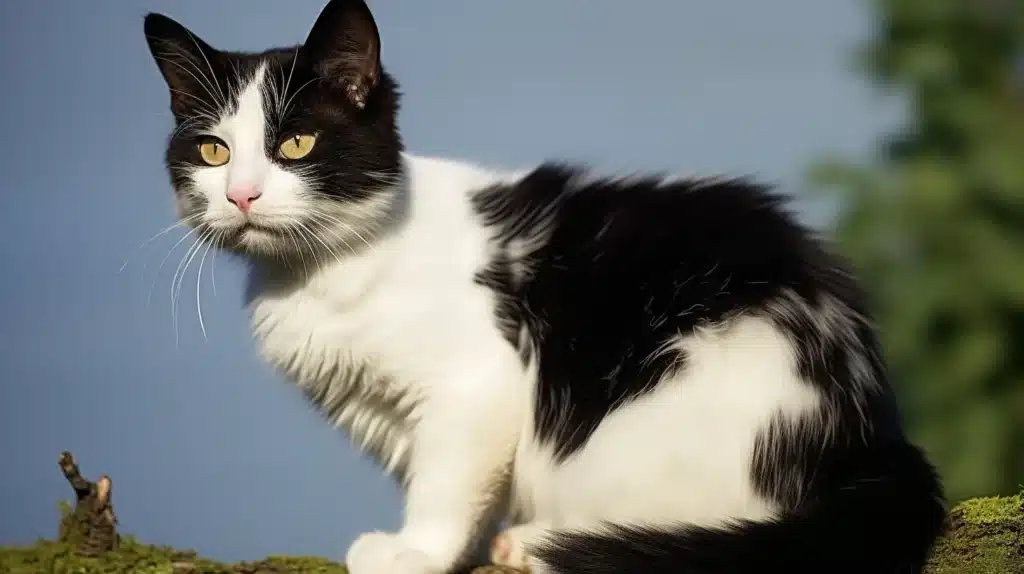
Nutritional Considerations and Health Tips
The nutritional needs of a Magpie Cat are similar to those of other domestic felines. A balanced diet rich in high-quality protein, crucial fatty acids, vitamins, and minerals is crucial for their overall well-being. Make sure to provide fresh water at all times and monitor their weight to prevent obesity, a common issue in cats. Additionally, regular veterinary check-ups are crucial to detect any health problems early on and ensure your Magpie Cat leads a long and healthy life.
- Choose a premium cat food that meets the nutritional requirements for your Magpie Cat’s age and activity level.
- Provide occasional treats in moderation to add variety to their diet and strengthen your bond with them.
With proper grooming and nutrition, along with regular veterinary care, you can provide your Magpie Cat with a happy and fulfilling life. Recognizing any changes in their behavior or appearance can help you address potential health issues promptly, ensuring your feline companion stays in the best possible condition.
Resources and Further Reading
Many cat owners find themselves in need of reliable information and guidance when it comes to caring for their beloved feline companions. At AskAboutCats.com, we offer a plethora of resources and further reading materials to assist cat parents in providing the best care for their cats.
Extensive Guides on Cat Care from AskAboutCats.com
Any cat owner looking to deepen their understanding of feline care will find our extensive guides on cat care invaluable. From detailed grooming techniques to comprehensive nutritional advice, our articles cover a wide range of topics to help you keep your cat happy and healthy. Whether you’re a first-time cat owner or a seasoned cat parent, our expertly curated guides will provide you with the knowledge and tools you need to give your feline friend the best possible care.
Connecting with Other Cat Enthusiasts and Experts
Care to connect with other cat enthusiasts and experts in the field? At AskAboutCats.com, we understand the importance of building a community around our shared love for felines. Join our forums to discuss cat behavior, share tips on cat care, and engage with fellow cat lovers. Our platform also features Q&A sessions with veterinary professionals, behaviorists, and other experts, offering you the opportunity to seek advice and gain insights from those with specialized knowledge in feline care.
With AskAboutCats.com, you’re not just accessing information – you’re entering a supportive and knowledgeable community dedicated to the well-being of all cats.
To wrap up
Ultimately, Magpie Cats are a striking and unique feline variety with a black and white spotted coat that resembles the plumage of a magpie bird. This captivating coat pattern is a result of genetics, where the “white spotting gene” creates large areas of white fur while a recessive allele of the “agouti gene” disrupts the banded color pattern, leading to the delightful random black spots. While living with a Magpie Cat doesn’t require any special care beyond the usual TLC, it’s important to distinguish them from tuxedo cats with a more defined black and white pattern.
Whether you’ve just encountered a Magpie Cat or are intrigued by their striking appearance, at AskAboutCats.com, we’re here to provide you with comprehensive information on all things feline. Do not forget, while breeders typically focus on established breeds rather than coat patterns, you can explore breeds like the Turkish Van known for their harlequin markings if you’re drawn to the Magpie-like coat. No matter the coat pattern, all cats deserve a loving home and proper care. Keep exploring AskAboutCats.com for more on cat breeds, coat variations, and everything you need to know to be a purrfect feline parent! Additionally, by learning about the unique traits of Magpie Cats, you’ll be better equipped to appreciate their charming personalities and quirks. These captivating cats may not be a specific breed, but their distinctive black and white coat pattern is sure to turn heads. At AskAboutCats.com, we celebrate the beauty and individuality of each and every cat, regardless of their breed or markings.
Frequently Asked Questions (FAQs)
Q: What is a Magpie Cat?
A: A Magpie Cat is a feline with a stunning black and white spotted coat and two colors, resembling the plumage of a magpie bird. This unique coat pattern is created by the presence of the “white spotting gene” creating large white areas and a recessive allele of the “agouti gene” causing random black spots.
Q: How does a Magpie Cat differ from a tuxedo cat?
A: Magpie Cats have a more random black and white spotting pattern, while tuxedo cats typically have a more defined black and white pattern resembling a formal suit. The coat pattern of Magpie Cats is a result of specific genetics, setting them apart from other cats with similar coloration.
Q: Do Magpie Cats require special care due to their coat pattern?
A: Magpie Cats do not typically require special care for their coat pattern. Regular grooming and general cat care guidelines are usually sufficient for these charming felines. If you’re looking for specific cat care advice, be sure to explore our comprehensive guides on grooming, nutrition, and overall well-being of your pet.
Q: What are magpie cats?
A: Magpie cats are a type of feline with a distinctive coat color pattern of black and white markings, resembling the appearance of the magpie bird.
Q: Do magpie cats have any specific breed traits?
A: Magpie cats usually have a combination of black and white markings on their bodies, with the black tail and typically white markings on their hind legs and paws.
Q: Are magpie cats a recognized cat breed?
A: Magpie cats are not a specific breed, but rather a term used to describe cats with black and white markings, such as tuxedo cats or piebald cats.
Q: Do magpie cats have any specific temperament traits?
A: Magpie cats are known to be affectionate, mischievous, and often get along well with children or other pets in the household.
Q: What is the history behind white and black cat?
A: Magpie cats have a rich history, with their distinctive black-and-white coat markings being a result of a genetic mutation. They have been cherished for their enigmatic elegance for centuries.
Q: Are all Grey or black and white cats considered magpie cats?
A: Not all black and white cats are considered magpie cats. Magpie cats usually have specific markings and patterns, differentiating them from other black and white cat breeds.
Q: Can magpie cats come in different coat lengths?
A: Yes, magpie cats can have shorthair or longhair coats, with variations in color distribution on their bodies, but they typically exhibit the black and white combination.
Q: Are there any special care instructions for magpie cats?
A: Magpie cats may require regular grooming, especially if they have long fur or white markings that can get dirty easily. They also need the same care and attention as any other domestic cat breed.
